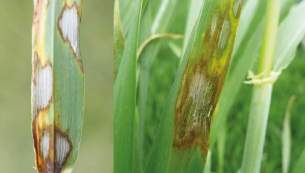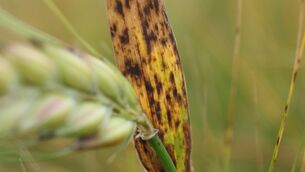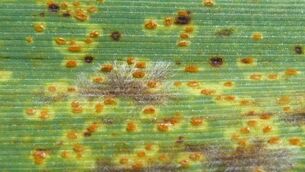- Delaro provides excellent control of scald and net blotch making it the ideal fungicide for use between GS30-32 in barley.
- Delaro is a convenient ready mixed formulation of prothioconazole and trifloxystrobin, two very effective fungicides with complimentary modes of action, saving you time and effort reducing the fungicides you stock.
- Delaro is very cost-effective, delivering high levels of prothioconazole and trifloxystrobin for a competitive price.

- Home
- Products
- Fungicides
- Delaro

Delaro
Delaro - the broad spectrum, cost effective fungicide for cereals and ryegrass seed crops.
Delaro is the ideal fungicide for early season use in barley and for late season disease control in wheat. Combining generous amounts of two complimentary non SDHI- fungicides at a competitive price, Delaro delivers excellent disease control.
-
Benefits
-
Crop Suitability & Usage
-
Resources
| Crop | Diseases Controlled |
|---|---|
| Barley | Scald, net blotch, ramularia leaf spot, leaf rust |
| Wheat | Stripe rust, leaf rust, speckled leaf blotch, glume blotch |
| Ryegrass | Crown rust, stem rust, blind seed disease |
| Product Type | Fungicide |
| Active Ingredient | Prothioconazole 175 g/L Trifloxystrobin 150 g/L |
| Formulation Type | Emulsifiable concentrate |
| Pack Size | 10L |
| Application Rate/Timing | Apply 600 - 750 ml/ha. Apply on first appearance of disease. Use the higher rate when disease pressure is high. Should disease pressure persist or re-infection occur, a further application may be required 3-4 weeks later. |
| Water Rate | Apply Delaro in at least 200 litres of water per hectare by ground or 50 litres per hectare by aerial application. |
| Withholding Period | Wheat, barley (grain): 56 days Wheat, barley (forage): 42 days Ryegrass (forage): 35 days Ryegrass (seed): 35 days |
| No. Applications/Season | Maximum two per season |
No results for this category. Please select a different one.
Latest Delaro news
Related Pests

Scald
Rhynchosporium secalis
Scald (Rhynchosporium secalis) is a common disease of barley which can result in significant yield loss if not controlled. Scald is favoured by cooler, moist conditions with the initial source of inoculum being infected straw
debris. The first symptoms often appear during winter or early spring, initially as pale greyish lesions which then develop a more straw coloured appearance with a defined dark edge to the lesion.

Net Blotch
Pyreophora teres
Net blotch (Pyreophora teres) is a common disease of autumn sown barley (much less commonly spring sown barley) which can result in significant yield loss if not controlled. Charateristics net type lesions
give the disease its common name but lesions can also take the form of dark stripes and streaks and when infection is severe in large dead areas of leaf. Infection sources are either seed or crop debris, which is borne out by second year barley crops being likely to carry infection. Net blotch development is favoured by cool, moist conditions.

Ramularia Leaf Spot
Ramularia collo-cygni
Ramularia leaf spot (Ramularia collo-cygni) is a common disease of barley which can result in significant yield loss if not controlled. While both winter and spring planted barley can be affected, the impact of Ramularia is
usually greater on winter planted crops. Ramularia is seed borne and once the fungus has infected the plant it grows within the plant, not producing visible symptoms until around ear emergence. Symptoms consist of small brown lesions which under the right conditions can rapidly increase and coalesce together.

Leaf Rust - Barley
Puccinia hordei
Leaf rust (also known as brown rust) is a disease of barley. Whilst occurring less frequently than leaf rust in wheat it can result in significant yield loss if not controlled. Leaf rust is favoured by
warmer, drier conditions with the initial source of inoculum being infected volunteer cereals. Under favourable conditions leaf rust can develop very quickly. Spores are scattered at random on the leaf and are often surrounded by a pale chlorotic halo.










